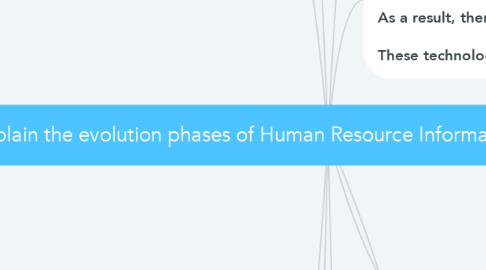RGGXX #08: By using a mind-map, explain the evolution phases of Human Resource Information System (HRIS) technology as explained in the ebook.
by GS T

1. Introduction The historical analysis that follows will demonstrate the growing importance of employees from being just one of the replaceable parts in organizations in the 20th century industrial economy to being a key source of sustainable competitive advantage in the 21st century knowledge economy. This means examining the evolution of HRM intertwined with developments in IT and describing how IT has played an increasing role in HRM.
2. 1) Pre World War II It is interesting to note that record keeping is one of the major functions built into the design of an HRIS today; however, there simply was no computer technology to automate the records at this time in history. Of course, paper records were kept, and we can still see paper record HR systems in many smaller firms today.
3. 2) World War II (1945-1960) The mobilization and utilization of labor during the war had a great impact on the development of the personnel function. With its changing and expanding role, the typical personnel department started keeping increasing numbers and types of employee records, and computer technology began to emerge as a possible way to store and retrieve employee information. Record keeping was still done manually despite the growing use of computerized data processing in other departments, such as accounts and materials management. What resulted was an initial reluctance among personnel departments to acquire and use computer technology for their programs.
4. 3) Social Issues Era (1963–1980) The decreasing costs of computer technology versus the increasing costs of employee compensation and benefits made the acquisition of computer-based HR systems (HRIS) a necessary business decision. As a result, there was an increasing demand for HR departments to adopt computer technology to process employee information more effectively and efficiently. These technology developments and increased vendor activity led to the development of a comprehensive management information system (MIS) for HRM.
5. 4) Cost-Effectiveness Era (1980–Early 1990s) Organizations began networking computers together, and the development of microcomputers (e.g., PCs) allowed organizations to leverage the power of both the mainframe and local computer to support HR operations. Organizations could now distribute employee information to multiple locations throughout the organization, providing more current information to managers in support of their personnel decisions. As noted earlier, the prevailing management thinking regarding the use of computers in HR was not that their use would result in a reduction in the number of employees needed in HR departments, but that employee activities and time could be shifted from transactional record keeping to more transformational activities that would add value to the organization.
6. 5) ERPs and Strategic HRM (1990–2010) The economic landscape underwent radical changes throughout the 1990s with increasing globalization, technological breakthroughs (particularly Internet-enabled Web services), and hyper competition. Human resources and the intellectual capital of employees were increasingly viewed as a strategic asset and a competitive advantage in improving organizational performance (Becker & Huselid, 2006). Using the data from an HRIS, HRP can provide estimates of whether or not there are enough internal employees or individuals in the external labor market of the new location available with the necessary skills to staff the new facility. In the late 1990s, software vendors began developing integrated enterprise resource planning systems, which integrated data from multiple functional areas of business, such as finance, accounting, marketing, HR, production, and sales.
7. 6) “The Cloud” and Mobile Technologies (2010– Present) Rather than the traditional ERP, organizations are increasingly moving to cloud-based HR systems, which are accessible over mobile devices and which leverage the capabilities of social networking and Web 2.0 tools. This creates a new hurdle for HR professionals as they learn to navigate the distribution of data on many more types of devices and on systems that are internally controlled by HR and by those systems outside of organizational control (e.g., Twitter, Facebook, Instagram, etc.).
8. Conclusion Ultimately as we will see in the ensuing chapters, although technology is a key enabler of strategic HRM, it is not simply the best technology and best strategy that leads to competitive advantage, but rather the fit between the environmental realities, technology, and strategic practices that lead to competitive advantage.
9. Thank for watching.


